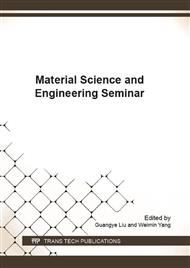[1]
W.L. Chan, M.W. Fu. Studies of the interactive effect of specimen and grain sizes on the plastic deformation behavior in microforming. Int J Adv Manuf Technol, 2012, 62: 989-1000.
DOI: 10.1007/s00170-011-3869-2
Google Scholar
[2]
J.T. Gau, C. Principe, J.W. Wang. An experimental study on size effects on flow stress and formability of aluminum and brass for microforming. J Mater Process Tech, 2007, 184(1-3): 42-46.
DOI: 10.1016/j.jmatprotec.2006.11.003
Google Scholar
[3]
J.T. Gau, C. Principe, M. Yu. Springback behavior of brass in micro sheet forming. J Mater Process Tech, 2007, 191(1-3): 7-10.
DOI: 10.1016/j.jmatprotec.2007.03.035
Google Scholar
[4]
S.A. Parasiz, B. Kinsey, N. Krishnan, J. Cao, M. Li. Investigation of deformation size effects during microextrusion. J Manuf Sci Eng, 2007, 129(4): 690-690.
DOI: 10.1115/1.2738107
Google Scholar
[5]
S.G. Kang, Y. Na, K.Y. Park, J.E. Jeon, S.C. Son, J.H. Lee. A study on the micro-formability of Al 5083 superplastic alloy using micro-forging method. Mater Sci Eng, 2007, 449: 338-342.
DOI: 10.1016/j.msea.2006.01.166
Google Scholar
[6]
J. Cao, W.M. Zhuang, S.W. Wang, J.G. Lin. Development of a VGRAIN system for CPFE analysis in micro-forming applications. Int J Adv Manuf Technol, 2010, 47(9-12): 981-991.
DOI: 10.1007/s00170-009-2135-3
Google Scholar
[7]
Y.H. Zhao, Y.Z. Guo, Q. Wei, T.D. Topping, A.M. Dangelewicz, Y.T. Zhu, T.G. Langdon, E.J. Lavernia. Influence of specimen dimensions and strain measurement methods on tensile stress-strain curves. Mater Sci Eng, 2009, 525(1-2): 68-77.
DOI: 10.1016/j.msea.2009.06.031
Google Scholar
[8]
G. Simons, C. weippert, J. Dual, J. Villain. Size effects in tensile testing of thin cold rolled and annealed Cu foils. Mater Sci Eng, 2006, 416(1-2): 290-299.
DOI: 10.1016/j.msea.2005.10.060
Google Scholar
[9]
C. Barbier, S. Thibaud, P. Picart. Size effects on material behavior in microforming. Int J Mater Form suppl, 2008, 1: 439-442.
DOI: 10.1007/s12289-008-0089-x
Google Scholar
[10]
C. Barbier, S. Thibaud, F. Richard, P. Picart. Size effects on material behavior in microforming. Int J Mater Form suppl, 2009, 1: 625-628.
DOI: 10.1007/s12289-009-0563-0
Google Scholar
[11]
G. Ehsan, M.J. Tan, E.W.J. Anders, S.C.V. Lim. Progressive microforming process: towards the mass production of micro-parts using sheet metal. Int J Adv Manuf Technol, 2013, 66: 611-621.
DOI: 10.1007/s00170-012-4352-4
Google Scholar
[12]
L.D. Cheng, C.J. Wang, C.J. Wang, B. Guo, Z.L. Wang. Size effects on plastic deformation behavior in micro radial compression of pure copper. Trans Nonferrous Met Soc China, 2013, 23: 2686-2691.
DOI: 10.1016/s1003-6326(13)62785-5
Google Scholar
[13]
E. Bernd, E. Ulf, G. Manfred. Microforming and investigation of parameter interactions. Prod Eng Res Devel, 2010, 4: 135-140.
Google Scholar
[14]
R.S. Eriksen, S. Weidel, H.N. Hansen. Tribological influence of tool surface roughness within microforming. Int J Mater Form, 2010, 3(1): 419-422.
DOI: 10.1007/s12289-010-0796-y
Google Scholar


